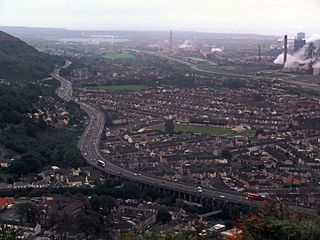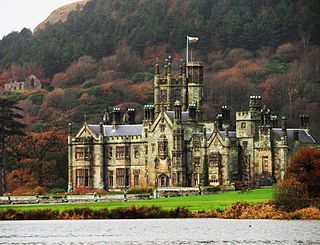
Port Talbot is a town and community in the county borough of Neath Port Talbot, Wales, situated on the east side of Swansea Bay, approximately eight miles from Swansea. The Port Talbot Steelworks covers a large area of land which dominates the south east of the town and is one of the biggest steelworks in the world but has been under threat of closure since the 1980s. The population was 37,276 in 2011.

Neath is a market town and community situated in the Neath Port Talbot County Borough, Wales. The town had a population of 50,658 in 2011. The community of the parish of Neath had a population of 19,258 in 2011. Historically in Glamorgan, the town is located on the River Neath, seven miles east-northeast of Swansea.

Neath Port Talbot is a county borough in the south-west of Wales. Its principal towns are Neath, Port Talbot, Briton Ferry and Pontardawe. The county borough borders Bridgend County Borough and Rhondda Cynon Taf to the east, Powys and Carmarthenshire to the north; and Swansea to the west.

Maesteg is a town and community in Bridgend County Borough, Wales. Maesteg lies at the northernmost end of the Llynfi Valley, close to the border with Neath Port Talbot. In 2011, Maesteg had a population of 20,612. The English translation of Maesteg is 'fair field'.

Margam Castle, Margam, Port Talbot, Wales, is a Victorian country house built for Christopher Rice Mansel Talbot. Designed by Thomas Hopper, the castle was constructed in a Tudor Revival style over a ten-year period, from 1830 to 1840. The site had been occupied for some 4,000 years. A Grade I listed building, the castle is now in the care of Neath Port Talbot County Borough Council.
Margam is a suburb and community of Port Talbot in the Welsh county borough of Neath Port Talbot, Wales, close to junction 39 of the M4 motorway. The community had a population of 3,017 in 2011; the built up area being larger and extending into Taibach community.
Sandfields is a mainly residential district of Port Talbot, Wales. The area is located in South Wales on a narrow coastal plain between Mynydd Dinas and the sea. The M4 motorway, A48 trunk road and South Wales Main Line run nearby. The area includes a council estate, industrial areas and a seaside resort at Aberavon Beach.

Bryncoch is a suburb of the town of Neath in Neath Port Talbot County Borough, Wales. The name derives from the Welsh 'red hill', originally the name of a nearby farm.

Blaengwrach is a community near Glynneath and Resolven in the county borough of Neath Port Talbot, Wales. It is also the name of an electoral ward of Neath Port Talbot county borough, which is a larger area than the Community. The principal settlement is Cwmgwrach, a village on the south side of the Neath valley, of which the eastern end is called Blaengwrach, which sometimes causes confusion.
Dyffryn Clydach is a community of Neath Port Talbot county borough, Wales, between Neath and Swansea.
Glan Afan Comprehensive School was a mixed comprehensive school which served the town of Port Talbot, Wales, and its surrounding areas for 120 years. It was opened in 1896 as Port Talbot Intermediate School under the provisions of the Welsh Intermediate Education Act 1889. The school closed in July 2016 to facilitate the merger of Glan Afan itself, Dyffryn Comprehensive, Sandfields Comprehensive, Cwrt Sart Comprehensive, and Traethmelyn Primary School into the ultra-modern £40millon 'super-school', Ysgol Bae Baglan.

Pontardawe Arts Centre is a multi-purpose cultural venue in Pontardawe, Neath Port Talbot, Wales. The building is owned by Neath Port Talbot County Borough Council and is located in Herbert Street.
Waterfall Country is an English name often given to the Vale of Neath in South Wales. The tourist area around the head of valley has an unusually large number of publicly accessible waterfalls. The area is not officially defined but generally includes the group of falls on the Nedd Fechan, Pyrddin, Hepste and Mellte rivers, all of which lie between the villages of Pontneddfechan and Ystradfellte in the Brecon Beacons National Park.

The Victoria Gardens is a Grade II registered park in the town centre of Neath, Wales.
Aberdeen has been the host of several theatres and concert halls through history. Some of them have been converted or destroyed over the years.

St Catharine's Church is the mother church of the parish of Baglan in Port Talbot, South Wales.

The Plaza is an abandoned cinema in Port Talbot. The building is listed for protection as Grade II. The cinema opened in April 1940. It has a modern design with Art Deco influences. Patrons included Richard Burton and Anthony Hopkins.

Roxy Theatre and Peters Greek Cafe Complex is a heritage-listed theatre and cafe at 74 Maitland Street, Bingara, Gwydir Shire, New South Wales, Australia. It was designed by Mark Woodforde and built in 1936. It was added to the New South Wales State Heritage Register on 25 August 2017.

Neath Town Hall is a municipal building in Church Place, Neath, South Wales. The town hall, which was the headquarters of Neath Borough Council, is a Grade II listed building.














